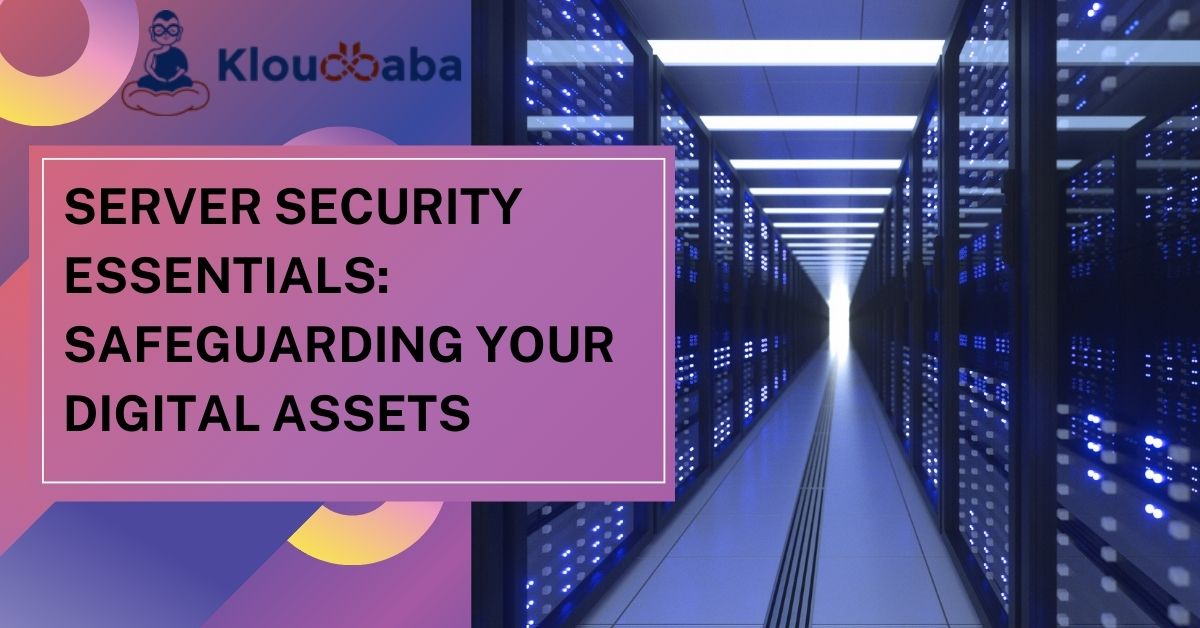
Server Security Essentials: Safeguarding Your Digital Assets
Server Security Essentials: Safeguarding Your Digital Assets-In the ever-evolving landscape of digital technologies, ensuring robust server security is paramount to safeguarding your valuable digital assets. As businesses and individuals increasingly rely on cloud platforms and diverse technologies, the need for comprehensive protection against cyber threats becomes more crucial than ever. In this blog post, we delve into the fundamental aspects of “Server Security Essentials,” shedding light on key components, best practices, and the significance of staying informed in a rapidly changing cybersecurity landscape.
Whether you’re a seasoned IT professional or just beginning your journey into server management, understanding and implementing these essentials are vital steps in fortifying your digital infrastructure. Join us on this insightful exploration, as Kloudbaba, your trusted resource for AWS, Azure, AI-ML, DevOps, Development, Testing, and Engineering courses, guides you through the crucial elements of securing your servers effectively.
Also Check: Desktop Engineering : A Kloudbaba Guide to Success
Understanding the Threat Landscape
As we embark on our exploration of “Server Security Essentials,” it’s imperative to grasp the ever-evolving threat landscape that poses potential risks to your digital assets. In an era where cyber threats are becoming more sophisticated, understanding the nature of these challenges is the first step towards fortifying your server defenses.
A. Emerging Trends in Cyber Threats
The digital realm is witness to a constant evolution of cyber threats, from traditional malware to advanced persistent threats (APTs). Staying abreast of emerging trends allows you to proactively address potential vulnerabilities, ensuring that your server security measures remain resilient in the face of evolving risks.
B. Impact of Server Vulnerabilities on Digital Assets
Server vulnerabilities can have far-reaching consequences, ranging from data breaches and financial losses to reputational damage. Delving into real-world examples will illuminate the potential ramifications of overlooking server security, emphasizing the critical need for a robust defense strategy.
C. Real-world Examples of Security Breaches and Their Consequences
Examining past security breaches provides valuable insights into the methods employed by cybercriminals and the fallout that organizations face. By learning from these incidents, you can enhance your server security posture and better protect your digital assets against similar threats.
In the subsequent sections of this blog post, we’ll delve deeper into the essential components of server security, offering actionable insights and best practices to empower you in safeguarding your digital infrastructure. Stay tuned for a comprehensive guide on securing your servers effectively.
Key Components of Server Security
Now that we’ve established the dynamic landscape of cyber threats, let’s dive into the foundational elements that constitute robust “Server Security Essentials.” Understanding and implementing these key components are pivotal in creating a secure environment for your digital assets.
A. Access Control Measures
Effective access control is the cornerstone of server security. Implementing Role-based Access Control (RBAC) and Two-Factor Authentication (2FA) not only restricts unauthorized access but also adds layer of defense against potential breaches.
1. Role-based Access Control (RBAC)
RBAC ensures that users have the necessary permissions based on their roles within the organization. This granular approach minimizes the risk of unauthorized access and helps maintain the principle of least privilege.
2. Two-Factor Authentication (2FA) Best Practices
By requiring users to provide two forms of identification, 2FA adds an extra layer of security beyond just passwords. Exploring best practices in implementing 2FA enhances your server’s resilience against unauthorized access attempts.
B. Encryption Protocols
Protecting data both in transit and at rest is non-negotiable for server security. Examining Secure Sockets Layer (SSL) and Transport Layer Security (TLS) protocols for data in transit, along with disk encryption for data at rest, ensures comprehensive protection against potential threats.
1. SSL/TLS Protocols for Data in Transit
Implementing SSL/TLS protocols encrypts the data exchanged between servers and clients, safeguarding it from interception by malicious entities.
2. Disk Encryption for Data at Rest
Encrypting data stored on server disks adds an extra layer of protection, ensuring that even if physical access is gained, the data remains unreadable without the encryption key.
C. Regular Software Updates and Patch Management
Servers must be kept up-to-date with the latest security patches to address vulnerabilities promptly. Timely updates and effective patch management play a crucial role in preventing exploits that target known weaknesses.
1. Importance of Timely Updates
Understanding the critical nature of software updates and their role in closing potential security loopholes is essential for maintaining a secure server environment.
2. Best Practices for Patching Server Vulnerabilities
Implementing best practices in patch management ensures that your servers are fortified against known vulnerabilities, reducing the risk of exploitation.
Also Check: Mastering the Art of Server Management Full Guide
Best Practices for Server Hardening
As we delve deeper into our exploration of “Server Security Essentials,” the focus now shifts toward the proactive measures of server hardening. Strengthening the security posture of your servers involves implementing best practices that mitigate potential vulnerabilities and fortify your digital defenses.
A. Operating System Security
Securing the underlying operating system is a fundamental step in server hardening. By implementing robust measures, you can create a resilient foundation for safeguarding your digital assets.
1. Configuring Firewalls and Intrusion Detection Systems
Firewalls act as the first line of defense, controlling incoming and outgoing network traffic. Coupled with Intrusion Detection Systems (IDS), they provide a comprehensive approach to identifying and preventing unauthorized access attempts.
2. Disabling Unnecessary Services and Ports
Minimizing the attack surface is crucial for server security. Disabling unnecessary services and ports that are not essential to your operations reduces potential entry points for cyber threats.
B. Application Security
Beyond the operating system, securing applications is equally critical. By adopting secure coding practices and leveraging additional protective measures, you can enhance the overall security of your server-based applications.
1. Code Reviews and Secure Coding Practices
Regular code reviews help identify and rectify security vulnerabilities in the early stages of development. Adhering to secure coding practices ensures that applications are resilient to common exploits.
2. Web Application Firewalls (WAFs) for Online Applications
For online applications, Web Application Firewalls (WAFs) serve as a barrier against malicious HTTP traffic. Implementing WAFs adds an extra layer of protection for web-facing applications, shielding them from common web-based attacks.
Monitoring and Incident Response
As we continue our journey through “Server Security Essentials,” we shift our focus to proactive measures for maintaining a secure server environment. Vigilant monitoring and a well-defined incident response plan are crucial components in swiftly addressing potential threats and mitigating their impact on your digital assets.
A. Implementing Robust Logging Mechanisms
Centralized logging is the backbone of effective server monitoring. By aggregating and analyzing logs from various sources, you gain valuable insights into server activities, enabling the early detection of anomalous behavior or potential security incidents.
B. Proactive Monitoring of Server Activities
Continuous monitoring is key to identifying and responding promptly to potential security threats. Implementing tools and practices that provide real-time visibility into server activities empowers you to take proactive measures before issues escalate.
C. Developing an Effective Incident Response Plan
No matter how robust your preventive measures are, having a well-defined incident response plan is essential. This plan should outline the steps to be taken in the event of a security incident, ensuring a swift and coordinated response to minimize the impact on your digital assets.
Also Check: Cloud Architect Salaries in the US (2024)
Training and Skill Development
As we near the culmination of our exploration into “Server Security Essentials,” we acknowledge the pivotal role of continuous education in maintaining robust server security. In this section, we highlight the importance of training and skill development, emphasizing how staying informed can empower you to navigate the intricate landscape of server security effectively.
A. Importance of Continuous Education in Server Security
The field of cybersecurity is dynamic, with new threats and technologies emerging regularly. By prioritizing continuous education, you equip yourself with the knowledge and skills needed to adapt to evolving challenges, ensuring your server security measures remain effective and up-to-date.
B. Kloudbaba’s Role in Providing Courses
At Kloudbaba, we understand the significance of staying ahead in the fast-paced world of technology. Our comprehensive courses cover a spectrum of domains, including AWS, Azure, AI-ML, DevOps, Development, Testing, and Engineering. In this context, we offer specialized courses specifically designed to enhance your proficiency in “Server Security Essentials.”
C. Specific Courses Addressing Server Security Essentials
Explore our curated courses that delve into the intricacies of server security. From foundational principles to advanced techniques, our content is crafted to cater to varying skill levels. Enroll in courses tailored to AWS and Azure security, AI-ML best practices, DevOps security measures, and more. Elevate your expertise and fortify your digital assets with the knowledge gained from our industry-leading instructors.
Conclusion
In this comprehensive guide to “Server Security Essentials,” we’ve explored the fundamental components, best practices, and the ever-evolving landscape of cybersecurity. Whether you’re an IT professional, a developer, or someone looking to enhance your skill set, understanding and implementing these essentials are vital steps in fortifying your digital infrastructure.
Join Kloudbaba on a journey of continuous learning, and empower yourself to navigate the challenges of server security with confidence. Explore our courses today and level up your skills in AWS, Azure, AI-ML, DevOps, Development, Testing, and Engineering, with a specific focus on server security essentials.
Tag:Access Control, AI-ML, Application Security, AWS, Azure, Continuous Education, Cybersecurity, Development, DevOps, Digital Assets Protection, Encryption Protocols, Engineering, Incident Response, IT Security, Kloudbaba Courses, Patch Management, Server Hardening, Server Security, Skill Development, Testing




